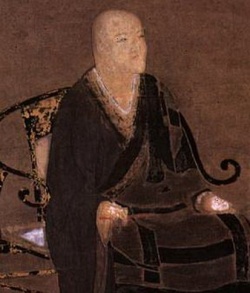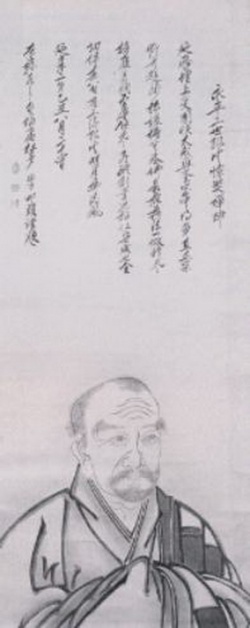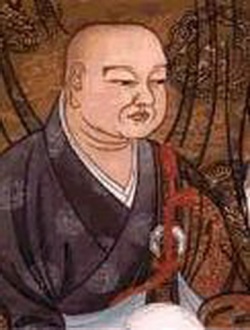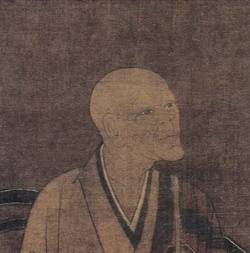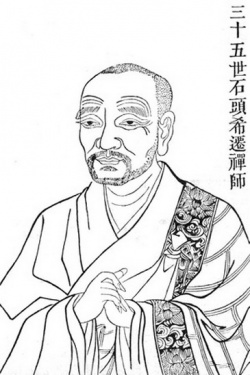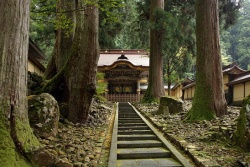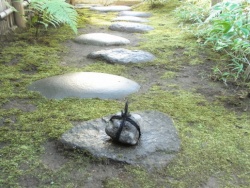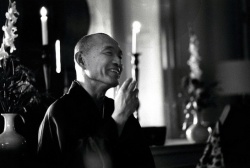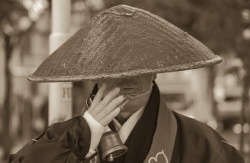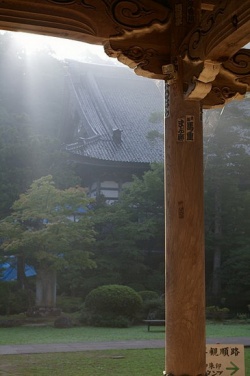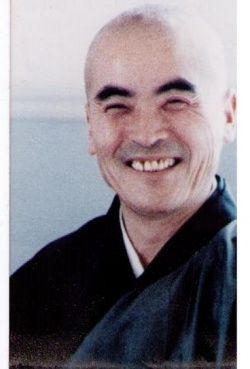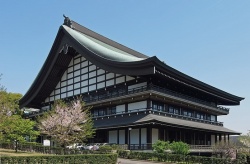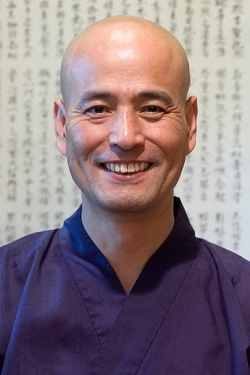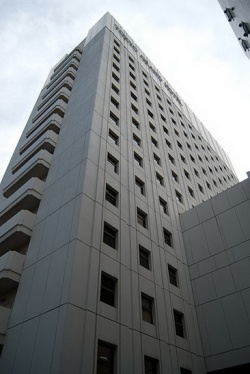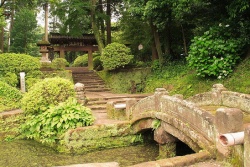Sōtō
Sōtō Zen or the Sōtō school (曹洞宗 Sōtō-shū?) is the largest of the three traditional sects of Zen in Japanese Buddhism (the others being Rinzai and Ōbaku). It emphasizes Shikantaza, meditation with no objects, anchors, or content. The meditator strives to be aware of the stream of thoughts, allowing them to arise and pass away without interference.
The Japanese brand of the sect was imported in the 13th century by Dōgen Zenji, who studied Caodong Buddhism (Chinese: 曹洞宗; pinyin: Cáodòng Zōng) abroad in China. Dōgen is remembered today as the co-patriarch of Sōtō Zen in Japan along with Keizan Jōkin.
With about 14,000 temples, Sōtō is one of the largest Japanese Buddhist organizations. Sōtō Zen is now also popular in the West, and in 1996 priests of the Sōtō Zen tradition formed the Soto Zen Buddhist Association based in North
History
Chinese origins
The original Chinese version of Soto-shu, i.e. the Caodong-school (曹洞宗) was established by the Tang dynasty monk Dongshan Liangjie (Ja: Tōzan Ryōkai) in the 9th century.
One prevalent view is that the sect's name was originally formed by taking one character each from the names of Dongshan and his disciple Caoshan Benji(曹山本寂, Tōzan Ryōkai), and was originally called Dongcao sect (with the characters in transposed order). However, to paraphrase the Dongshan Yulu (《洞山語録》, "Record of the Dialogues of Dongshan"), the sect's name denotes 'colleagues (曹) of the teachings above the caves (洞)' who together follow the "(black wind (teachings of Taoism)])" and admire the masters of various sects.
Perhaps more significantly for the Japanese brand of this sect, Dōgen among others advocated the reinterpretation that the "Cao" represents not Caoshan, but rather "Huineng of Caoxi temple" 曹渓慧能 (Sōkei Enō); zh:曹溪慧能). The branch that was founded by Caoshan died off, and Dōgen was a student of the other branch that survived in China.
A precursor to the sect is Shítóu Xīqiān (Ch. 石頭希遷, ca.700 - ca.790), the attributed author of the poem Sandokai, which formed the basis of Song of the Precious Mirror Samadhi of Dongshan Liangjie (Jp. Tōzan Ryōkai) and the teaching of the Five Ranks.
Kamakura (1185-1333)
Dogen
The Caodong-teachings were brought to Japan in 1227, when Dōgen returned to Japan after studying Ch'an in China and settled at Kennin-ji in Kyoto. Dōgen had received Dharma transmission from Tiantong Rujing at Qìngdé Temple, where Hongzhi Zhengjue once was abbot. Hongzhi's writings on "silent illumination" had greatly influenced Dōgen's own conception of shikantaza.
Dogen did return from China with various koan anthologies and other texts, contributing to the transmission of the koan tradition to Japan. In the first works he wrote he emphasised the practice of zazen, which brought him into trouble at Kennin-ji:
This assertion of the primacy of Zen aroused the anger of the Enryaku-ji monks, who succeeded in driving Dōgen from the Kennin-ji where he had settled after his return to the capital.
In 1243 Dogen founded Eihei-ji, one of the two head temples of Sōtō-shū today, choosing...
... to create new monastic institutions based on the Chinese model and risk incurring the open hostility and opposition of the established schools.
Daily routine was copied from Chinese practices, which went back to the Indian tradition:
The elements of Soto practice that contributed most to the success of the school in medieval Japan were precisely the generic Buddhist monastic practices inherited from Sung China, and ultimately from India. The Soto Zen style of group meditation on long platforms in a sangha hall, where the monks also took meals and slept at night, was the same as that prescribed in Indian Vinaya texts. The etiquette followed in Soto monasteries can also be traced back to the Indian Vinaya.
Ejo
Dōgen was succeeded around 1236 by his disciple Koun Ejō (1198–1280), who originally was a member of the Daruma school of Nōnin, but joined Dogen in 1229. Ejo started his Buddhist studies at Mount Hiei, the center of Tendai studies. following his stay there he studied Pure Land Buddhism under Shōkū, whereafter he joined the Daruma school of Nōnin by then led by Kakuan.
Ejo, like Dōgen, believed in the primacy of Zen Buddhism. He resisted efforts from outside to water down the tradition with other beliefs.
Gikai
Tettsū Gikai
A large group from the Daruma-school under the leadership of Ekan joined the Dogen-school in 1241, after severe conflicts with the Tendai and Rinzai schools. Among this group were Gikai, Gien and Giin, who were to become influential members of Dogen's school.
After the death of Ejō, a controversy called the sandai sōron occurred. In 1267 Ejo retired as Abbot of Eihei-ji, giving way to Gikai, who was already favored by Dogen. Gikai too originally was a member of the Daruma school, but joined Dogen's school in 1241, together with a group from the Nōnin school led by Ekan. Gikai introduced esoteric elements into the practice:
[W]ith the premature death of Dōgen the group lost its focus and internal conflicts led to a split. Dōgen's followers soon introduced such esoteric elements as prayers and incantations into the teaching.
Opposition arose, and in 1272 Ejo resumed the position of abbot. After his death in 1280, Gikai became abbot again, strengthened by the support of the military for magical practices. Opposotion arose again, and Gikai was forced to leave Eihei-ji, and exiled to Kaga province, Dajō-ji (in Ishikawa prefecture). He was succeeded by Gien, who was first trained in the Daruma-school of Nōnin. His supporters designated him as the third abbot, rejecting the legitimacy of Gikai.
Keizan
The second most important figure in Sōtō, Keizan, belonged to this dissident branch. Keizan received ordination from Ejo when he was, twelve years old, shortly before Ejo's death When he was seventeen he went on a pilgrimage for three years throughout Japan. During this period, he studied Rinzai, Shingon and Tendai. After returning to Daijo-ji, Keizan received dharma transmission from Gikai in 1294, and established Joman-ji. In 1303 Gikai appointed Keizan as abbot of Daijo-ji, a position he maintained until 1311.
Keizan enlarged the Shingon-temple Yōko-ji in Ishikawa prefecture, turning it into a Zen monastery in 1312. There-after he inherited the Shingon temple Shogaku-ji in 1322, renaming it Sōji-ji, which was recognized as an official monastery. In 1324 put Gasan Jōseki in charge of Sojo-ji, and returned to Yōkoji. Yōko-ji was Keizan's main temple, but Sōji-ji thrived better, thanks to Gasan Jōseki
Though today Dogen is referred as the founder of Soto, for a long period Soto history recognized several important ancestors, next to Dogen. In 1877 the heads of the Sōtō community acknowledged Keizan for a brief period as the overall founder of the Sōtō sect.
Dogen is known as the "koso", where Keizan is known as the "taiso";
Both terms mean the original patriarch, that is, the founder of Japanese Sōtō Zen tradition.
Soto-centers
At the end of the Kamakura period, Dogen's school centered around four centers, namely Eihei-ji, Daijo-ji monastery, and the temples Yoko-ji and Soji-ji. Soki-ji became the most influential center of the Dogen-school.
Muromachi (or Ashikaga) (1336-1573)
During the Muromachi period the Rinzai school was the most successful of the schools, since it was favoured by the Shogun. But Soto too spread out over Japan.
Gasan and Sotetsu
Gasan Jōseki (1275–1365) and Meiho Sotetsu were Keizan's most prominent students.
Gasan too started his Buddhist studies at mount Hiei. He became head of soji-ji in 1324. Gasan adopted the Five Ranks of Tung-shan as a fit vehicle to explain the Mahayana teachings.
Sotetsu became head of Yoko-ji in 1325. Initially his influence soon grew. In 1337 Sotetsu was appointed as abbot of Daijo-ji.
Azuchi-Momoyama (1573-1600) and Edo (or Tokugawa) (1600-1868)
After a period of war Japan was re-united in the Azuchi–Momoyama period. Neo-Confucianism gained influence at the expense of Buddhism, which came under strict state control. The power of Buddhism decreased during the Tokugawa-period. Buddhism had become a strong political and military force in Japan and was seen as a threat by the ruling clan. Measures were taken to control the Buddhist organisations, and to limit their power and influence. The temple hierarchy system was centralized and unified.
Japan closed the gates to the rest of the world. New doctrines and methods were not to be introduced, nor were new temples and schools. The only exception was the Ōbaku lineage, which was introduced in the 17th century during the Edo period by Ingen, a Chinese monk. The presence of these Chinese monks also influenced the existing Zen-schools, spreading new ideas about monastic discipline and the rules for dharma transmission.
The Soto-school started to place a growing emphasis on textual authority. In 1615 the bakufu declared that "Eheiji's standards (kakun) must be the rule for all Soto monks". In time this came to mean all the writings of Dogen, which thereby became the normative source for the doctrines and organisation of the Soto-school.
A key factor in this growing emphasis on Dogen was Manzan's appeal to change the rules for dharma transmission, based on arguments derived from the Shōbōgenzō. From its beginnings, Sōtō-shu has laid a strong emphasis on the right lineage and dharma transmission. In time, dharma transmission became synonymous with the transmission of temple ownership. When an abbot changed position, becoming abbot of another temple, he also had to discard his lineage and adopt the lineage of his new temple. This was changed by Manzan Dokahu (1636–1714), a Soto reformer, who...
Propagated the view that Dharma transmission was dependent on personal initiation between a Master and disciple rather than on the disciple's enlightenment. He maintained this view in the face of strong opposition, citing as authority the towering figure of Japanese Zen, Dogen [...] This became and continues to this day to be the official Soto Zen view.
Another reformation was implemented by Gento Sokuchu (1729–1807), the 11th abbot of Eihei-ji, who tried to purify the Soto-school, deemphasizing the use of koans. In the Middle Ages koan study was widely practiced in the Soto-school. Gento Sokuchu started the elevation of Dogen to the status he has nowadays, when he implemented new regulations, based on Dogen's regulations.
This growing status of Dogen as textual authority also posed a problem for the Soto-school:
The Soto hierarchy, no doubt afraid of what other radical reformers might find in Dogen's Shobo Genzo, a work open to a variety of interpretations, immediately took steps to restrict access to this traditional symbol of sectarian authority. Acting at the request of the Soto prelates, in 1722 the government prohibited the copying or publication of any part of Shobo Genzo.
Meiji Restoration (1868-1912) and Imperial expansionism
During the Meiji period (1868–1912) Japan abandoned its feudal system and opened up to Western modernism. Shinto became the state religion, and Buddhism was coerced to adapt to the new regime. Rinzai and Soto Zen chose to adapt, with embarrassing consequences when Japanese nationalism was endorsed by the Zen institutions. War endeavours against Russia, China and finally during the Pacific War were supported by the Zen establishment.
Within the Buddhist establishment the Western world was seen as a threat, but also as a challenge to stand up to. Parties within the Zen establishment sought to modernize Zen in accord with Western insights, while simultaneously maintaining a Japanese identity.
During this period a reappraisal of Dōgen started. The memory of Dōgen was used to ensure Eihei-ji's central place in the Soto-organisation, and "to cement closer ties with lay people". In 1899 the first lay ordination ceremony was organized in Eihei-ji. Eihei-ji also promoted the study of Dōgen's works, especuially the Shōbōgenzō, which changed the view of Dōgen in Soto's history. An image of Dōgen was created that suited the specific interests of Eihei-ji:
Dōgen's memory has helped keep Eihei-ji financially secure, in good repair, and filled with monks and lay pilgrims who look to Dōgen for religious inspiration [...] the Dōgen we remember is a constructed image, an image constructed in large measure to serve the sectarian agendas of Eihei-ji in its rivalry with Sōji-ji. We should remember that the Dōgen of the Shōbōgenzō, the Dōgen who is held up as a profound religious philosopher, is a fairly recent innovation in the history of Dōgen remembrances.
Lay interests
Funerals continue to play an important role as a point of contact between the monks and the laity. Statistics published by the Sōtō school state that 80 percent of Sōtō laymen visit their temple only for reasons having to do with funerals and death, while only 17 percent visit for spiritual reasons and a mere 3 percent visit a Zen priest at a time of personal trouble or crisis.
Monastical training
In an advice to western practitioners, Kojun Kishigami Osho, a dharma heir of Kodo Sawaki, writes:
Every year, about 150 novices arrive. About 90 percent of them are sons of temple heads, which leaves only 10 percent who chose this path for themselves. For the autumn session, about 250 monks come together. Essentially what they are learning in these temples is the ability to officiate all kinds of ceremonies and rites practiced by the Soto School – the methods for fulfilling their role. Apart from this aspect, practicing with the idea of developing one’s own spirituality is not prevalent.
According to Kishigami, practice may as well be undertaken elsewhere:
If you want to study Buddhism, I recommend the Japanese universities. If you want to learn the ceremonies practiced by the Soto School, you need only head for Eihei-ji or Soji-ji.
But if your goal is to seriously learn the practice of zazen, unfortunately, I have no Japanese temple to recommend to you. Of course, you can go to Antai-ji, if you want; but if you want to deepen your practice of true Zen, you can do it in Europe. If you go to Japan for this, you will be disappointed. Don’t expect to find anything wonderful there.
Spread in the western world
In the 20th century Soto-Zen spread out to the west.
Shunryu Suzuki
Shunryu Suzuki played a central role in bringing Sōtō to the west. Suzuki studied at Komazawa University, the Sōtō Zen university in Tokyo. In 1959 Suzuki arrived in California to attend to Soko-ji, at that time the sole Sōtō temple in San Francisco. His book Zen Mind, Beginner's Mind has become a classic in western Zen culture. Shunryu Suzuki's teaching of Shikantaza and Zen practice led to the formation of the San Francisco Zen Center, one of the largest and most successful Zen organizations in the West. The training monastery of the San Francisco Zen center, at Tassajara Hot springs in central California, was the first Buddhist Monastery to be established outside Asia. Today SFZC includes Tassajara Monastery, Green Gulch Farm, and City Center. Various Zen Centers around the U.S. are part of the dharma lineage of San Francisco Zen Center and maintain close organizational ties with it.
Sanbo Kyodan
The Sanbo Kyodan, in which Soto and Rinzai are merged, is also of central importance western Soto Zen. Their lineage, starting with Hakuun Yasutani, includes Taizan Maezumi, who gave dharma transmission to various American students, among them Tetsugen Bernard Glassman, Dennis Genpo Merzel, Charlotte Joko Beck and John Daido Loori.
In Europe the Sanbo Kyodan has been influential via Hugo Enomiya-Lassalle, and via students of Dennis Genpo Merzel, especially in the Netherlands.
Sanbo Kyodan was also connected to the Soen Nakagawa-Eido Tai Shimano lineage, due to a personal fondness of Soen for the teaching practices of Harada roshi, who was the teacher of Hakuun Yasutani.
Antai-ji
The Antaiji-based lineage of Kodo Sawaki is also widespread. Sawaki is regarded as one of the greatest Zen teachers of recent times. Sawaki's student and successor as abbot Kosho Uchiyama was the teacher of Shohaku Okumura who established the Sanshin Zen Community in Bloomington, Indiana, and his student Gudo Wafu Nishijima is the teacher of Brad Warner.
Soto Zen Buddhist Association
The larger majority of North American Sōtō priests joined together in 1996 to form the Soto Zen Buddhist Association. While institutionally independent of the Japanese Sōtōshū, the Sōtō Zen Buddhist Association works closely with what most members see as their parent organization. With about one hundred fully transmitted priests, the Sōtō Zen Buddhist Association now represents about 80% of Western Sōtō teachers. The Soto Zen Buddhist Association approved a document honoring the women ancestors in the Zen tradition at its biannual meeting on October 8th, 2010. Female ancestors, dating back 2,500 years from India, China, and Japan, may now be included in the curriculum, ritual, and training offered to Western Zen students.
Practice
Shikantaza
In the Soto school of Zen, Shikantaza, meditation with no objects, anchors, or content, is the primary form of practice. The meditator strives to be aware of the stream of thoughts, allowing them to arise and pass away without interference.
Considerable textual, philosophical, and phenomenological justification of this practice can be found throughout Dōgen's works:
In the first works he wrote after his return to Japan, the Fukan zazengi (Principles for the universal promotion of zazen) and Bendōwa (Distinguishing the Way), he advocated zazen (seated meditation) as the supreme Buddhist practice for both monks and laypersons.
Other important texts promoting zazen are the Shōbōgenzō, and the "Principles of Zazen" and the "Universally Recommended Instructions for Zazen".
Soto versus Rinzai
Sōtō Zen was often given the derogatory name "farmer Zen" because of its mass appeal. Some teachers of Zen would say that the reason why it was called "farmer Zen" was because of its down-to-earth approach, while the Rinzai school was often called "samurai Zen" because of the larger samurai following. The latter term for the Rinzai can be somewhat misleading, however, as the Sōtō school also had samurai among its rosters.
Texts
Sutras
Sōtō Zen, like all of Zen, relies on the Prajnaparamita Sutras, as well as general Mahayana Buddhist sutras, such as the Lotus Sutra, the Brahma Net Sutra and the Lankavatara Sutra. Zen is influenced in large part by the Yogacara school of philosophy as well as the Huayan school.
Until the promotion of Dogen studies in modern times, the study of Chinese texts was prevalent in Soto:
After textual learning was revived during the early Tokugawa period, most Japanese Sōtō monks still studied only well-known Chinese Buddhist scriptures or classic Chinese Zen texts.54 Eventually a few scholarly monks like Menzan Zuihō began to study Dōgen's writings, but they were the exceptions. Even when scholarly monks read Dōgen's writings, they usually did not lecture on them to their disciples.
Sōtō Zen texts
Shih-t'ou Hsi-ch'ien's (Shitou Xiqien, Sekito Kisen, 700–790) poem "The Harmony of Difference and Sameness" is an important early expression of Zen Buddhism and is chanted in Sōtō temples to this day.
One of the poems of Tung-shan Liang-chieh, the founder of Sōtō, "The Song of the Jewel Mirror Awareness" is also chanted in Sōtō temples. Another set of his poems on the Five Positions (Five Ranks) of Absolute and Relative is important as a set of koans in the Rinzai school.
Other texts typically chanted in Sōtō Zen temples include the Heart Sutra (Hannyashingyō), and Dōgen's Fukanzazengi (Universally Recommended Instructions for Zazen).
Dogen
Dōgen's teaching is characterized by the identification of practice as enlightenment itself. This is to be found in the Shōbōgenzō. The popularity of this huge body of texts is from a relatively recent date:
Today, when someone remembers Dōgen or thinks of Sōtō Zen, most often that person automatically thinks of Dōgen's Shōbōgenzō. This kind of automatic association of Dōgen with this work is very much a modern development. By the end of the fifteenth century most of Dōgen's writings had been hidden from view in temple vaults where they became secret treasures [...] In earlier generations only one Zen teacher, Nishiari Bokusan (1821–1910), is known to have ever lectured on how the Shōbōgenzō should be read and understood.
The study of Dogen, and especially his Shobogenzo, has become the norm in the 20th century:
Beginning in 1905 Eiheiji organized its first Shōbōgenzō conference (Genzō e)[...] Since 1905 it has become an annual event at Eiheiji, and over time it gradually changed the direction of Sōtō Zen monastic education[...] Sōtan's lectures provided a model that could be emulated by each of the other Zen monks who came to Eiheiji. This model has become the norm, not the exception. Today every Sōtō Zen teacher lectures on Dōgen's Shōbōgenzō.
Organisation
The Soto-shu organisation has an elaborate organisation. It consists of circa 15.000 temples. There are circa 30 training centers, where Soto-monks can train to become an oshō or priest and run their own temple.
Head and parliament
Soto-shu has a centralised organisation, run by a head:
Soto-shu is a democratic organization with a head (called 宗務総長 Shûmusôchô) that is elected by a parliament. The parliament in turn consist of 72 priests that are elected in 36 districts throughout Japan, 2 from each district. The Shûmusôchô selects a cabinet that consists of him and seven other priests who together govern the organization. It is commonly believed that the Kanchô, who is either the head of Eiheiji or Sôjiji, the two head temples, is the boss of Soto-shu. This is not the case. The Kanchô has only representational functions; the real power lies with the Shûmusôchô and his cabinet.
Temples
Contemporary Soto-shu has four classes of temples:
Honzan (本山?), head temples, namely Eihei-ji and Sōji-ji;
Kakuchi, teaching monasteries, where at least once a year an ango (ninety-day retreat) takes place;
Hōchi, dharma temples;
Jun hōchi, ordinary temples.
While Eihei-ji owes its existence to Dōgen, throughout history this head temple has had significantly fewer sub-temple affiliates than the Sōji-ji. During the Tokugawa period, Eiheiji had approximately 1,300 affiliate temples compared to Sōji-ji's 16,200. Furthermore, out of the more than 14,000 temples of the Sōtō sect today, 13,850 of those identify themselves as affiliates of Sōji-ji. Additionally, most of the some 148 temples that are affiliates of Eiheiji today are only minor temples located in Hokkaido— founded during a period of colonization during the Meiji period. Therefore, it is often said that Eiheiji is a head temple only in the sense that it is "head of all Sōtō dharma lineages.
Legal status
The Soto-shu is an "umbrella (hokatsu) organization for affiliated temples and organizations".It has "three sets of governing documents":
Sotoshu Constitution (Sotoshu shuken);
Regulations for the Religious Juridical Person Sotoshu (Shukyo honin Sotoshu kisoku);
